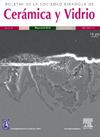Pre-industrial production of recycled ceramic tiles using construction and demolition waste: Exploring their technological feasibility
IF 2.7
4区 材料科学
Q1 MATERIALS SCIENCE, CERAMICS
Boletin de la Sociedad Espanola de Ceramica y Vidrio
Pub Date : 2025-09-09
DOI:10.1016/j.bsecv.2025.100468
引用次数: 0
Abstract
Annually, construction and demolition waste (CDW) represents one-third of the EU's waste generation. Due to its sheer volume and low-value applications, there is growing interest in its valorisation for new building products. One promising avenue is the incorporation of CDW in recycled ceramic tile production, though this remains largely unexplored at the pre-industrial level. This research examines the viability of pre-industrial-scale production of recycled ceramic tiles with a high content of CDW. CDW materials from a management plant, including ceramic waste (tiles) and mixed debris (construction ceramics and concrete), were processed to create compositions containing up to 10 wt% mixed debris. Virgin clay was added in different proportions, resulting in 55, 70, and 100 wt% CDW compositions. Results show that spray-dried characteristics allow tile production with up to 70 wt% recycled content. The compositions containing 70 and 55 wt% CDW were tested pre-industrially, fired at 1145–1155 °C. The 55 wt% CDW mixture achieves characteristics comparable to those of pre-industrial ceramic tiles, producing novel recycled products with high waste content. These tiles had a flexural strength of >41 N/mm2, surpassing the market standard for porcelain stoneware (35 N/mm2), and water absorption of 12%, meeting wall tile specifications. An economic and environmental assessment highlights the benefits of using CDW in ceramic tiles, highlighting the potential for an environmentally responsible and resource-efficient approach within the tile industry, while minimising environmental impact and preserving natural resources.

利用建筑垃圾和拆迁垃圾生产再生瓷砖的前工业化生产:探索其技术可行性
每年,建筑和拆除垃圾(CDW)占欧盟垃圾产生量的三分之一。由于其庞大的体积和低价值的应用,人们对其用于新建筑产品的价值增值越来越感兴趣。一个有希望的途径是将CDW纳入再生瓷砖生产中,尽管这在工业化前的水平上仍未得到很大的探索。本研究考察了工业化前规模生产高CDW含量的再生瓷砖的可行性。来自管理工厂的CDW材料,包括陶瓷废料(瓷砖)和混合碎片(建筑陶瓷和混凝土),经过处理,制成含有高达10 wt%混合碎片的组合物。以不同的比例添加原生粘土,得到55%、70%和100% wt%的CDW成分。结果表明,喷雾干燥特性允许瓷砖生产高达70% wt%的回收含量。含有70 wt%和55 wt% CDW的组合物在工业前测试,在1145-1155°C下烧制。55%的CDW混合物实现了与工业前瓷砖相媲美的特性,生产出具有高废物含量的新型回收产品。这些瓷砖的抗折强度为41 N/mm2,超过了陶瓷陶瓷的市场标准(35 N/mm2),吸水率为12%,符合墙砖规格。经济和环境评估强调了在瓷砖中使用CDW的好处,强调了在瓷砖行业中采用环保和资源节约型方法的潜力,同时最大限度地减少对环境的影响并保护自然资源。
本文章由计算机程序翻译,如有差异,请以英文原文为准。
求助全文
约1分钟内获得全文
求助全文
来源期刊

Boletin de la Sociedad Espanola de Ceramica y Vidrio
工程技术-材料科学:硅酸盐
CiteScore
5.50
自引率
2.90%
发文量
72
审稿时长
103 days
期刊介绍:
The Journal of the Spanish Ceramic and Glass Society publishes scientific articles and communications describing original research and reviews relating to ceramic materials and glasses. The main interests are on novel generic science and technology establishing the relationships between synthesis, processing microstructure and properties of materials. Papers may deal with ceramics and glasses included in any of the conventional categories: structural, functional, traditional, composites and cultural heritage. The main objective of the Journal of the Spanish Ceramic and Glass Society is to sustain a high standard research quality by means of appropriate reviewing procedures.
 求助内容:
求助内容: 应助结果提醒方式:
应助结果提醒方式:


